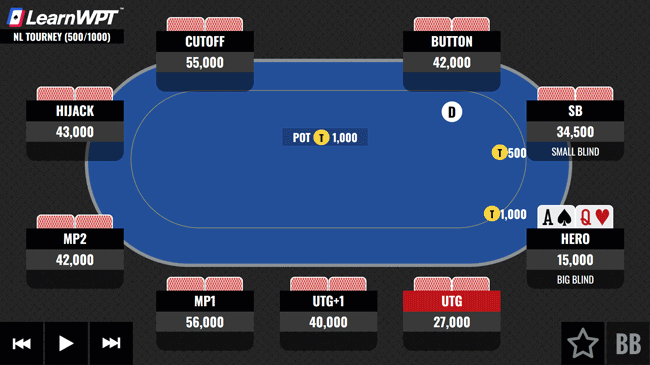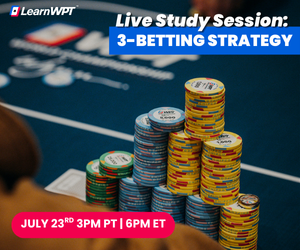Poker Quiz! Facing a UTG Raise With A♠Q♥ in the Big Blind...
DECISION POINT: You are in the middle stages of a daily tournament with blinds at 500/1,000 and a 1,000 big blind ante. Your stack is down to 15,000 (15BBs) after losing a sizable pot. The player in the UTG seat, who is a regular in this tournament and you’ve observed using GTO-style opening ranges, raises to 2,300. The action folds to you in the Big Blind with A♠Q♥ — what do you do here?
PRO ANSWER: We’re in the middle stages of a daily tournament with 20-minute levels. The blinds are 500/1,000 with a 1,000 big blind ante. The UTG player is a regular you've seen use GTO-style opening ranges when first to enter the pot. After losing a sizable pot, we start this hand with 15,000 chips after posting the big blind and ante. We’re dealt A♠Q♥ in the Big Blind. The UTG player opens to 2,300, and action folds around to us.
When playing in the Big Blind against a single raiser, since we have the option of closing the action by calling, we will often find ourselves using a much more polarized range for our re-raises. A polarized range is a range where we will be re-raising our strongest hands that are far ahead of our opponent’s range as well as some weaker semi-bluffs for balance.
Considering the range the UTG player should be opening, if they are in fact utilizing GTO style first-in opening hand ranges, they should be opening around 18% of hands in this situation.
Continued below...
AQo is in the top 5% of overall hands preflop, making it well ahead of our opponent’s opening hand range. This makes our hand a great candidate to move all-in with.
If we had a read that our UTG opponent was raising much narrower in early position than they should based on GTO defaults, we could exploitatively adjust by flat calling. It is a frequent mistake many players make to simply call in the Big Bind with a hand this strong compared to their opponents first-in hand range. When we call we’re going to miss flopping a pair around two thirds of the time and our opponent’s range often contains hands like JTs that have decent equity against us, but would likely fold to an all-in.
By moving all-in instead of calling, we can avoid tricky situations postflop where we might fold the best hand, which is catastrophic at this stack depth.
Moving all-in is the best play.
How would you play it?
Share your answer in the comments below!
Improve Your Game Today!
Join LearnWPT and Get:
- The WPT GTO Trainer to play real solved hands and get instant feedback on YOUR leaks (over 4 BILLION solved spots!)
- On-demand access to our full library of 500+ (and growing) in-depth Strategy Episodes from world-class players
- All of your poker questions answered with the Ask a Pro Feature
- Expert analysis from LearnWPT Pros using The Hand Input Tool
- Downloadable Tools you can use at and away from the tables
- Learn from a Team of world-class Professional Players
To join (just $5 your 1st month) click the JOIN NOW button and start improving your game!
Have Questions about LearnWPT? Email us at [email protected].


